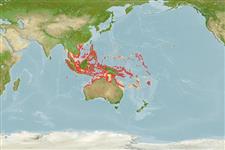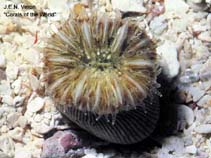Heterocyathus aequicostatus Milne-Edwards & Haime, 1848
Striped bum coral| Native range | All suitable habitat | Point map | Year 2050 |

|
| This map was computer-generated and has not yet been reviewed. |
| Heterocyathus aequicostatus AquaMaps Data sources: GBIF OBIS |
Classification / Names Common names | Synonyms | CoL | ITIS | WoRMS
| Scleractinia | Caryophylliidae
Environment: milieu / climate zone / depth range / distribution range Ecologia
Associadas(os) a recifes; intervalo de profundidade 0 - 40 m (Ref. 847). Tropical; 22°N - 26°S, 95°E - 180°E (Ref. 847)
Distribuição Países | Áreas FAO | Ecossistemas | Ocorrências | Introduções
Indo-Pacific.
Length at first maturity / Tamanho / Peso / Idade
Maturity: Lm ? range ? - ? cm
Free-living, solitary corals with a flat base. Commonly occurs on soft horizontal substrates at 20 m or more. Only at night do polyps extend. Associated with other corals, Heteropsammia cochlea and Cycloseris cyclolites (Ref. 3477).
Life cycle and mating behavior Maturidade | Reprodução | Desova | Ovos | Fecundidade | Larvas
Members of the class Anthozoa are either gonochoric or hermaphroditic. Mature gametes are shed into the coelenteron and spawned through the mouth. Life cycle: The zygote develops into a planktonic planula larva. Metamorphosis begins with early morphogenesis of tentacles, septa and pharynx before larval settlement on the aboral end.
Referência principal
Referências | Coordenador | Colaboradores
Veron, J.E.N. 2000. (Ref. 847)
Categoria na Lista Vermelha da IUCN (Ref. 130435)
Preocupação menor (LC) ; Date assessed: 01 January 2008
Categoria CITES (Ref. 108899)
Appendix II: International trade monitored
CMS (Ref. 116361)
Not Evaluated
Ameaça para o homem
Utilização humana
| FishSource |
Ferramentas
Mais informação
Idade/Tamanho
Crescimento
Comprimento-peso
Comprimento-comprimento
Morfologia
Larvas
Abundância
Crescimento
Comprimento-peso
Comprimento-comprimento
Morfologia
Larvas
Abundância
Fontes da internet
BHL | BOLD Systems | CISTI | DiscoverLife | FAO(Publication : search) | Fishipedia | GenBank (genoma, nucleotídeo) | GloBI | Gomexsi | Google Books | Google Scholar | Google | PubMed | Hexacorallians of the World | Árvore da vida | Wikipedia (ir para, procurar) | Registo zoológico
Estimates based on models
Preferred temperature
(Ref. 115969): 26 - 29, mean 28.3 (based on 696 cells).
Categoria de preço
(Ref. 80766):
Unknown.



